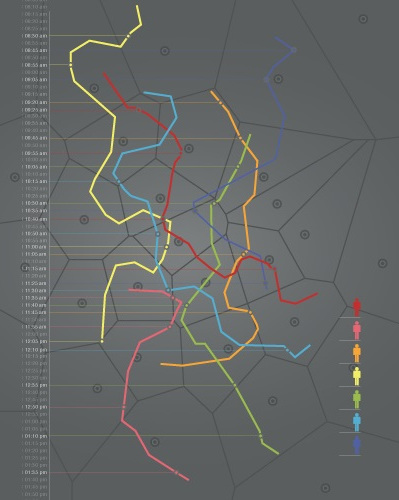A person among 1,500,000 users of mobile communication can be identified only by 4 points in time and space
 Every day, each of us is in the same places at about the same time - home, work, gym, shop, house again ... Our daily route is quite stable and at the same time unique. A joint study of American and Belgian scientists has shown that its degree of uniqueness is much higher than can be expected.
Every day, each of us is in the same places at about the same time - home, work, gym, shop, house again ... Our daily route is quite stable and at the same time unique. A joint study of American and Belgian scientists has shown that its degree of uniqueness is much higher than can be expected.An analysis of the database in which anonymized information was collected about the time and place of calls and SMS to 1,500,000 subscribers for fifteen months showed that to identify 95% of people it’s enough to know only four space-time points.
Only two points make it possible to distinguish an individual trace of half of the users, and eleven is enough to distinguish every single trace. The illustration on the left shows examples of such individual traces. The authors of the study compare the uniqueness of the mobile footprint with fingerprints - in 1930, the French forensic pioneer Edmon Locard showed that for identification by fingerprint, twelve matches of the pattern are enough.
')
Thus, by obtaining from public sources (Facebook, Twitter, Foursquare, LinkedIn, etc.) only a few characteristic time-space points, one can de-anonymize the mobile subscriber among millions of records that do not contain any personal information at all, and track all his move.
It does not even require special accuracy - in the database used for the analysis, space was determined by the base station of mobile communication, and the time was indicated with an accuracy of one hour. Moreover, the uniqueness of mobile traces, although it decreased with a decrease in spatial and temporal resolution, was rather slow and easily compensated by an increase in the number of points.
The graph on the left shows the dependence of the degree of uniqueness of the trace when sampling from four, and on the right - from ten points. On the horizontal axis, the temporal resolution in hours is plotted, on the vertical one - spatial (number of base stations):

Large crowds of people are not a hindrance - the density of the base stations of mobile communication is very well correlated with the population density. If in rural areas one base station gives a spatial accuracy of 15 km 2 , in cities it is 0.15 km 2 and above. In addition, 94% of people almost never leave the territory with a radius of about 100 km. Thus, this method is well scaled for a huge number of subscribers, and for large areas.
Source: https://habr.com/ru/post/174221/
All Articles